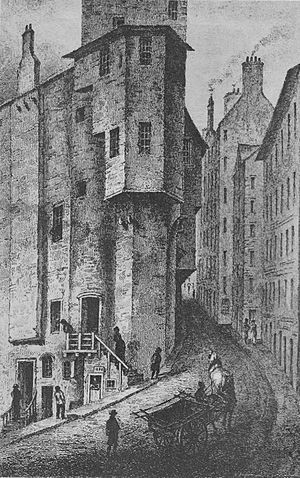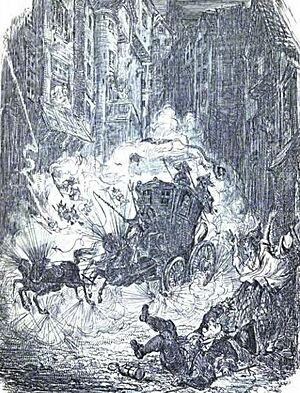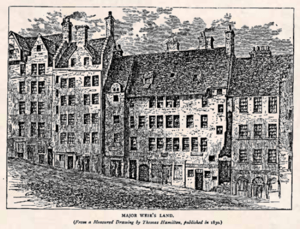Thomas Weir facts for kids
Major Thomas Weir was a Scottish soldier and a very religious man from the 1600s. He was known for his strong beliefs and for leading prayers, which made many people respect him. He lived in Edinburgh and was sometimes called the "Bowhead Saint" because of his home's location and his deep religious faith. However, his story took a very surprising turn later in his life.
Major Weir's Life
Thomas Weir was born in a place called Carluke in Scotland. He came from a powerful and old family. His mother was even thought to have special abilities to see the future.
Weir became a soldier and fought for the Scottish army against the King. He served as a lieutenant in Ireland in the 1640s. Later, in 1650, he became the commander of the Edinburgh Town Guard, which gave him the rank of major. He was even in charge when a famous general named Montrose was executed in Edinburgh.
Major Weir lived with his sister, Grizel, in a house near the West Bow in Edinburgh. Because of his religious reputation, he and his neighbors were known as the "Bowhead Saints."
A Shocking Confession
In 1670, when Major Weir was around 70 years old, he became very ill. From his sickbed, he started to confess to a secret life of bad deeds. At first, the city's leader, Andrew Ramsay, didn't believe him because Weir had such a good reputation.
But soon, Weir and his sister, Jean Weir (also known as Grizel), were taken to the Tolbooth prison in Edinburgh for questioning. Major Weir kept adding to his confession. His sister Grizel also made some very strange claims. She talked about witchcraft and other unusual things. She even said that a "fiery" coach once took her brother to Dalkeith, where he learned about a battle defeat on the same day it happened.
Grizel also claimed that Major Weir got his power from his walking stick, which had a carved human head on top. She said the stick was sometimes seen moving by itself down the street in front of him!
Even though Major Weir was a respected public figure, his own confession, along with his sister's strange stories, led to their trial. They were found guilty and sentenced to death.
Major Weir was executed and his remains were displayed. His thornwood walking stick was also burned. It was said to twist in strange ways in the fire. The remains of Major Weir and his sister were buried at the base of the gallows.
The Haunted House
After Major Weir's execution, his house in the West Bow stayed empty for over 100 years. People believed it was haunted. Stories said that one of Weir's spells made people think they were going down the stairs when they were actually going up!
Around 1780, a former soldier named William Patullo bought the house cheaply and moved in with his wife. But they supposedly ran out of the house on their very first night. They claimed to have seen a strange ghost of a calf that came into their room, stood on its front legs at the end of their bed, and stared at them.
Because of Major Weir's spooky story, the top part of the West Bow was known as "Major Weir's Land" for two centuries. People also believed his ghost haunted the area for 100 years.
Major Weir's story might have even inspired famous writers. It's thought to have influenced Robert Louis Stevenson's book Dr Jekyll and Mr Hyde. Also, a novel called The Fanatic by James Robertson features Major Weir as a character.




